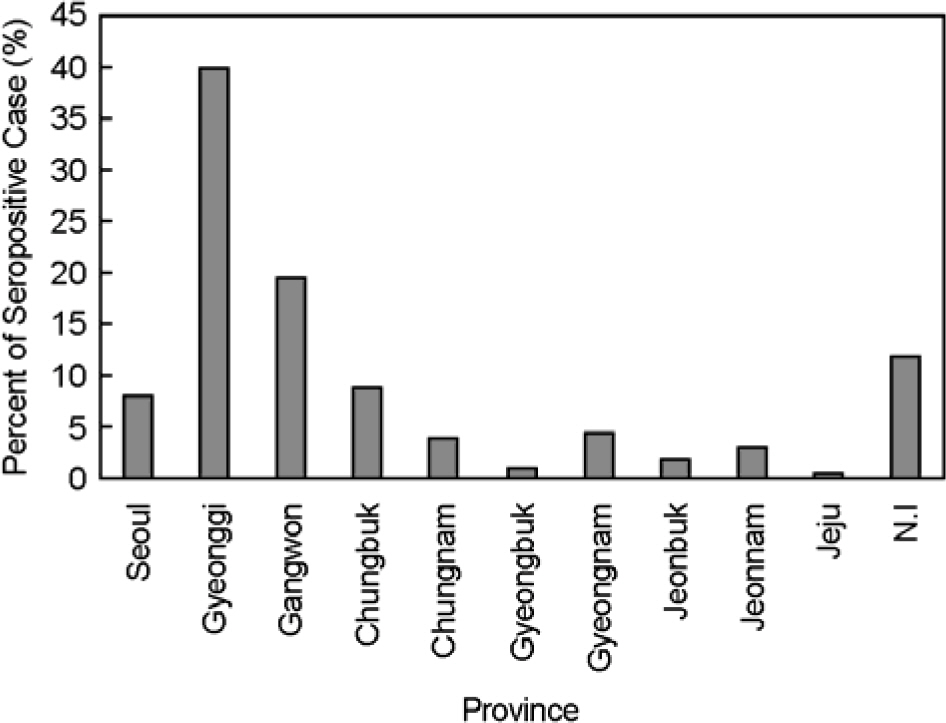J Bacteriol Virol.
2006 Dec;36(4):263-269. 10.4167/jbv.2006.36.4.263.
Seroepidemiological Characteristics of Haemorrhagic Fever with Renal Syndrome from 1996 to 2005 in Korea
- Affiliations
-
- 1Division of Arboviruses, Center for Immunology and Pathology, National Institute of Health, Center for Disease Control and Prevention, 194, Tongil-lo, Eunpyung-gu, Seoul, Korea. 3801474@hanmail.net
- 2Division of Epidemic Intelligence Service, National Institute of Health, Center for Disease Control and Prevention, 194, Tongil-lo, Eunpyung-gu, Seoul, Korea.
- 3Department of Biotechnology, The Catholic University of Korea, 43-1 Yeokgok dong, Wonmi-ku, Bucheon, Korea.
- 4Division of Microbiology, Jeollanam-do Institute of Health and Environment, Gwangju, Korea.
- KMID: 2055035
- DOI: http://doi.org/10.4167/jbv.2006.36.4.263
Abstract
- Haemorrhagic fever with renal syndrome (HFRS) caused by Hantaan viruses has been one of the principal acute febrile disease in Korea. To analysis the sero-epidemiological patterns of HFRS, 4,177 patient sera of acute febrile illness submitted for serological assay to National Institute of Health from Community Health Centers, Institutes of Health and Environment and hospitals from 1996 to 2005 were examined for antibodies against Hantaan virus by indirect immunofluorescent assay (IFA). Serum samples with greater than 1:32 antibody titer were considered positive. The results were analyzed seroepidemiologically by annual, sexual, seasonal, age and regional distribution of HFRS patients. Out of 4,177 serum samples tested, 1,415 samples (33.9%) were positive to Hantaan virus. The ratio of males (48.2%, 682/1,415) to females (38.2%, 541/1,415) was 1.3:1. Seasonal incidence showed that 69.5% (985/1,415) of cases occurred from October to December, resulting with higher prevalence in November (41.3%, 584/1,415). Regionally, seropositive rates of samples collected in Gyenggi, Gangwon and Chungbuk were 39.9% (564/1,415), 19.3% (274/1,415) and 8.5% (120/1,1415), respectively. Age distributions of seropositive of HFRS were detected from 20 to 79 years (78%).
MeSH Terms
Figure
Cited by 1 articles
-
Case of Hemorrhagic Fever with Renal Syndrome in Jeju Island
Chae Moon Lim, Sang Taek Heo, Jinseok Kim, Jung Re Yu, Young Ree Kim, Keun Hwa Lee
Infect Chemother. 2012;44(6):454-457. doi: 10.3947/ic.2012.44.6.454.
Reference
-
References
1). 국립보건원. 전염병 보고 및 정보관리지침. 135. 2002.2). 송병학, 홍승진, 정용태, 박완배, 백순영, 김태규, 유문 간, 김금용. 1998년∼2002년 서울 강남성모병원에 내원 한 환자 혈청에서 한탄바이러스 감염에 대한 혈청 역학 적 조사. J Bact Virol. 33:329–335. 2003.3). 송진원, 이종은, 김상현, 기선호, 박광숙, 백락주, 송기 준. 1997년∼1998년 한국에서 발생한 열성 질환에 대한 혈청 역학적 연구. Kor J Virol. 32:263–267. 2002.4). 송진원, 장영식, 반상자, 김승한, 조해월. 한국 주민에 서 한탄바이러스에 대한 항체 보유률 및 분포 조사. Kor Soc of Vrol. 21:135–140. 1991.5). 우영대, 박상욱, 강재명, 우준희, 이호왕. 1994년∼2000 년 사이에 혈청학적으로 진단된 신증후출혈열의 혈청 역학적 조사. J Bact Virol. 31:193–198. 2001.6). 이호왕, 박성배, 주용규. 1980년∼1987년 한국에서 발생 한 신증후출혈열 환자의 혈청 역학적 조사. J Kor Soc of Virol. 18:131–142. 1988.7). 정수용, 송기준, 송진원, 문성실, 김은주, 박광숙, 기선 호, 백락주. 신종 수청바이러스와 무주바이러스의 혈청 학적 특성. J Bact Virol. 35:No.(3):249–255. 2005.8). Chun CH, Kim SW, Kim WD, Yoon HJ. Changing pattern of epidemiology and death causes of epidemic haemorrhagic fever. Kor J Infect Dis. 8:58–74. 1976.9). Chun CH, Won OS. The analysis of death causes of 50 fetal cases in korean haemorrhagic fever. Kor J Infect Dis. 5:57–62. 1973.10). Enria DA, Pinheiro F. Rodent-borne emerging viral zoonosis. Hemorrhagic fevers and hantavirus infections in South America. Infect Dis North Am. 14:167–184. 2000.11). Kim IK, Kim HR, Huh MS, Park SG, Jang WJ, Seong SY, Choi MS. Seroepidemiological survey of haemorrhaggic fever with renal syndrome in Korea, 1994∼1996. J Kor Soc Microbiol. 34:245–251. 1999.12). Lee HW. Vaccination of haemorrhagic fever with renal syndrome. J Kor Acad Med. 13:No.(11):32–39. 1992.13). Lee HW, Baek LJ, Johnson KM. Isolation of Hantaan virus, the etiologic agent of Korean haemorrhagic fever from wild urban rats. J Infect Dis. 146:638–644. 1982.14). Lee HW, Baek LJ, Doo CD. The study on breeding season of Apodemus agrarius, the natural host of Korean haemorrhagic fever. Kor J Virol. 11:1–8. 1981.15). Lee HW, Lee PW. Korean haemorrhagic fever I. Demonstration of causative antigen and antibodies. Kor J Internal Med. 19:371–383. 1976.16). Lee HW, Lee PW, Johnson KM. Isolation of the etiologic agent of korean haemorrhagic fever. J Infect Dis. 137:298–308. 1978.17). Schmaljohn CS, Dalrymple JM. Analysis of Hantaan virus RNA: Evidence for a new genus of Bunyaviridae. Virol. 131:482–491. 1983.18). Schmaljohn CS, Hasty SE, Harrison SA, Dalrymple JM. Characterization of Hantaan virions, the prototype virus of haemorrhagic fever with renal syndrome. J Infect Dis. 148:1005–1011. 1983.19). Padula PJ, Edelstein A, Miguel SDL, Lopez NM, Rossi CM, Rabinovich RD. Hantavirus Pulmonary syndrome outbreak in Argentina: Molecular evidence for person-to-person transmission of Andes virus. Virol. 241:323–330. 1998.
Article
- Full Text Links
- Actions
-
Cited
- CITED
-
- Close
- Share
- Similar articles
-
- Seroepidemiological Survey of Hemorrhagic Fever with Renal Syndrome in Korea , 1994 - 1996
- Seroepidemiologic Survey of Haemorrhagic Fever With Renal Syndrome from 1994 till 2000
- Seroepidemiological survey of hemorrhagic fever with renal syndrome in korea, 1989-1991
- Seroepidemiological Survey of Hantavirus Infection of Wild Rodents Trapped from 1994 to 1998 in Korea
- A Case of Hemorrhagic Fever with Renal Syndrome with Stress-induced Cardiomyopathy




